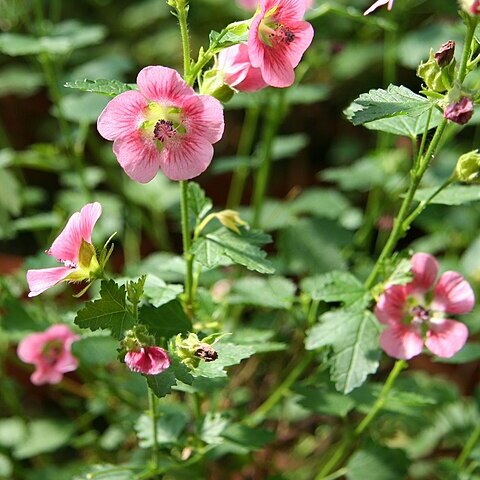Subshrubs to about 1 m tall; mostly sparsely to copiously stellate-pubescent, the hairs sessile to short-stalked, the arms mostly 4-10, appressed, coarse or fine, up to about 1 mm long; sometimes with a minute-stellulate indumentum as well. Leaf blades yellowish-green, thin, up to 2.5 cm. long, shallowly to deeply 3-(or 5-) lobed, the terminal lobe about equal to or up to twice as long as the lateral lobes, lance-oblong to narrowly or broadly oblong-obovate or ovate, sometimes once to thrice pinnate-lobate in the upper half, the margins serrate to deeply and broadly crenate-dentate or entire below a trifid apex, the lateral lobes of similar shape but somewhat asymmetrical, spreading, with open sinuses or, when broad, often with narrow, nearly closed sinuses, the ventral surface smooth, glabrate to copiously but inconspicuously pubescent with simple or stellate hairs, the dorsal surface stellate-pubescent; stipules appressed, to 3.5 mm long, 1.5 mm broad, deltoid-ovate to subulate. Inflorescence racemose, the flowers 1-2(-3) in the upper axils, erect in bud horizontal at anthesis; pedicels 2-25 mm long, not functionally articulate apically Involucral bracts 3, arising immediately below the calyx and appressed to it, green but often aging reddish-black, 1.5-5 mm long, 0.3-1 mm broad, filiform to oblong-oblanceolate, acute, the margins usually simple-ciliate. Calyx (4-)5-7(-9) mm long, slightly accrescent, copiously stellate-pubescent but the lobe margins usually simple-hirsute, the tube often whitish, the lobes greenish, spreading at anthesis generally aging reddish-black and clasping the fruit, 2.5-5(-7) mm long, 1.8-3.7 mm broad, deltoid to ovate, short-acuminate, about equaling to twice as long as the tube. Petals spreading in a flat whorl, not overlapping pale magenta grading to deep magenta above the auricles, 8-14 mm long 4-11 mm broad, obovate, obliquely rounded to bilobed apically, narrowed gradually or abruptly to the base, puberulent ventrally above the bearded auricles. Staminal column exserted, 4.5-7 mm long, pubescent centrally with a ring of spreading, simple to 4-5-branched hairs, the apex and filaments magenta; filaments to ca. 2 mm long, arising over the upper 1-2 mm of the column; anthers ca. 52-64, deep magenta. Fruit persistent, 5-6.3 mm in diam., discoid, without conspicuous grooves between the carpels, truncate or slightly concave at the style base, densely yellowish-pubescent apically and sometimes dorsally to near the base, the apical hairs mostly erect, setose, simple to few-branched, the dorsal hairs finer and more consistently stellate; carpels 9-12(-16), brownish or rarely reddish-brown, 2-2.4 mm high, 2.1-2.8 mm broad, depressed-orbicular to transversely elliptic in lateral view, the lateral walls smooth ventro-apically, otherwise fenestrate, the dorsolateral and basdateral edges often ridged, the endoglossum prominent. Seed solitary filling the lower cell, 1.3 x 1.3 to 1.9 x 1.7 mm, gray, reddish-brown, or reddish-black, papillate or ventrally puberulent.
More
Subshrub, 0.75-1.20 m high; stellate-pubescent, hairs sessile to short stalked, arms 4-10. Leaves simple to 3-or 5-lobed, terminal lobe longest; upper surface yellowish green, margins deeply crenate-dentate, apex trifid. Racemes 1-or 2(3)-flowered in upper axils. Epicalyx bracts 3, filiform, margins ciliate. Calyx campanulate, 5-lobed. Petals spreading in a flat whorl, pale to deep magenta, puberulent above bearded auricles. Staminal tube exserted; filaments in upper 2 mm of column, 2 mm long, anthers 52-64, magenta. Style branches as many as carpels. Flowering time Nov.-Apr. Fruit a schizocarp, discoid, truncate. Mericarps 9-12, reddish brown. Seeds reddish brown, papillate, ventrally puberulent.

